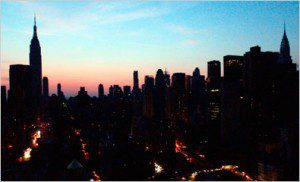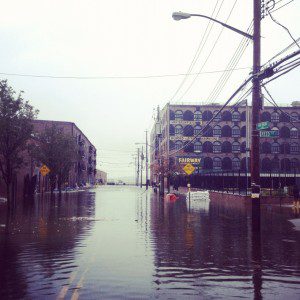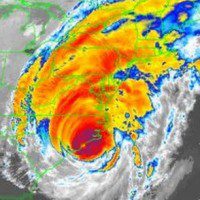The last storm of the century was on March 12, 1993. It was a freak spring superstorm, a little like this one–a cyclonic blizzard that merged with a nor’easter on its way up the coast. I was 10 years old and all my friends were sledding down the hill behind our elementary school without me. Instead, I was cooped up in the Marriott across from the recently bombed out World Trade Center, while my parents took meetings at 200 Liberty St. Our hotel room looked directly onto the remnants of the parking structure where the van with the bomb had been less than a month before. I remember because it feels like I spent hours looking at the damage that was still there, trying to decipher exactly what had gone down.
They’d been announcing that the storm would hit for a few days, but people really starting freaking out the day before. The general mood was memorable. As everyone frantically tried to get out of the city before it was shut down, my parents, ever the workaholics, frantically tried to get in. I was sour about all this–a perfectly wonderful snow day without any of the benefits of building snowmen or slurping mini-marshmallowy hot chocolates with my pals. Instead I was eating steak dinners, playing the freshly released first-person shooter game Doom in a large, empty newsroom and watching people cross-country ski down 6th Avenue.
II
I have no memories of The Blizzard of ’96. I must have been having fun.
III
Floyd had decidedly humble beginnings. The storm started as a tropical wave off the coast of Africa on September 2, 1999. Twelve days later, it had become a Category 4 hurricane, one of the largest ever recorded in The Atlantic Ocean. The storm barreled through the tri-state area, killing six people in New Jersey and two more in New York.
I was 16. My high school closed for two days, mainly on account of a little creek which has a much mightier name than it deserves. The Peckman River broke its banks on September 14th, flooding out the center of our town, closing roads and causing days of little local streets lined with heaps of the sad, soaked contents of basements, left out not to dry, but simply to be taken away. Perhaps this was its Napoleon Complex acting out.
IV
9/11 was not a storm in the classic sense, but in a more abstract way, it felt like one. It had all the characteristics–an assault on our way of life that seemed to come out of the blue; a period of shock followed by a period of frenzy, panic and cultural fetishism; the rarely seized-upon opportunity for New Yorkers to truly come together; the memory forever seared into our brains.
If it was a storm, it was the first one I was absent for. That I had missed it seemed lucky and unlucky all at once.
V
 The Blackout of ’03: another abstraction. That I was home at all was a strange miracle. I remember it was a hot August day. I agreed to go into the city with a friend who was thinking of having a sex change. I was to provide moral support after the initial meeting with the doctor. I sat in the waiting room awkwardly sweating, biding my time, guiltily breezing through a crumpled issue of People Magazine.
The Blackout of ’03: another abstraction. That I was home at all was a strange miracle. I remember it was a hot August day. I agreed to go into the city with a friend who was thinking of having a sex change. I was to provide moral support after the initial meeting with the doctor. I sat in the waiting room awkwardly sweating, biding my time, guiltily breezing through a crumpled issue of People Magazine.
The lights went off in the office. The doctor came out and informed us that the building had lost power and that we would all have to go home.
We wandered outside to get the car. There was a line around the block for the payphone. Even in 2003, this was a weird sight.
“Maybe it’s the whole block,” I said.
We got in the car and the chaos began. All the stoplights were out at the peak of rush hour in midtown. Pulling out of the subterranean parking structure was almost impossible. Kind, brave citizens directed traffic. Everyone couldn’t help feeling like another terrorist attack was occurring and you could tell that everyone was trying to talk themselves out of this feeling.
As we reached the George Washington Bridge, we switched on the radio.
All of Manhattan had lost power.
“All of Manhattan!” we shrieked.
Update: it’s a five-borough blackout. The first since 1977.
“Five-borough blackout!” we shrieked.
From there, the cities and states fell like dominoes, more storm-like behavior. Newark. All of New Jersey. And Pennsylvania. And Ohio. And Michigan.
“And Michigan!” we shrieked.
We saw men in suits walking across the GWB carrying black briefcases, looking hot but strangely relieved.
When I got back to my parent’s house, I found that the power was freakishly on, even though the rest of the town’s was still out. It was nice, comforting—home; a small cluster of lights in a sea of darkness.
VI
The blizzard that started on December 26, 2010 was the first anyone called a Snowpocalypse. The storm was bad–20 inches bad–but the way the city reacted was worse. The only snowplow our neighborhood had for days was a rickety old garbage truck. A plow had been hastily added to its front bumper, affixed with a strand of red twine that looked like it had been rigged up by a drunk third grader. The morning after the storm, we watched it spin its wheels, stuck in the snow, as we walked to get supplies at the local grocery store. On our way back to the apartment, the truck was still stuck there, and a crowd had gathered to laugh and mock the city’s incompetent response. More mockery cascaded through the Internet, as a video of another plow repeatedly slamming into a citizen’s car was re-watched again and again and again on YouTube, much to the chagrin of public officials. Snowpocalypse I is the reason that those evacuation zones even exist today at all. Bloomberg made sure that his administration would never again be the butt of another natural disaster-related joke.
I remember it clearly because we were leaving New York. We came back to our place from celebrating Christmas at my parent’s house the night the storm started. It was dark and beautiful and cold and crisp. It was hard to walk through it, but still enjoyable.
When we woke the next morning, we had to dig out of my garden apartment. We packed for the next three days straight, interrupted only by an ill-fated trek to Williamsburg for a lunch date with a friend and a cab ride to our new storage unit where the cabbie told me I was crazy to be moving in this weather. I did not find this reassuring, being told I was crazy by a man who spent most of his days fighting New York City traffic for a living.
Each night, we would drop to bed exhausted. Each morning, we would rise early to start again. We finally finished on New Year’s Eve, handed the keys over to the subletter, took a power nap at a friend’s house and then reveled the night away, slipping drunk on still snow-packed sidewalks. This is what New York is all about.
VII
 I mostly experienced Sandy through social media and the Internet–Facebook, Instagram, emails, some rogue texts and regular news outlet updates. The videos of water seeping tsunami-like into neighborhoods that had never seen water before made me feel sick to my stomach. The images of the subways flooding out and the Brooklyn-Battery Tunnel looking like a clogged drain made me feel even worse.
I mostly experienced Sandy through social media and the Internet–Facebook, Instagram, emails, some rogue texts and regular news outlet updates. The videos of water seeping tsunami-like into neighborhoods that had never seen water before made me feel sick to my stomach. The images of the subways flooding out and the Brooklyn-Battery Tunnel looking like a clogged drain made me feel even worse.
At midnight, we realized that that storage space we had moved our stuff into during Snowpocalypse 2010 was in Zone A and panicked slightly.
In the morning, I checked in with friends and family. Dad, Karen and the kids without power, but fine. Mom and Frank with a dusting of snow in The Blue Ridge Mountains. Grandma went to Metuchen to stay with a great aunt, thank god, avoiding the massive flooding around her Monmouth Beach condo. The New Yorkers seemed to all be fine—our friends were lucky enough to live on higher ground in Brooklyn, Manhattan and Queens. An aunt in Long Island City was an exception—still waiting to hear back from her. The Jersey City kids didn’t fare as well and they were all holed up in Pat’s fourth floor apartment, waiting it out, charging their devices at the solar-powered Shop Rite.
I arranged a favor remotely, sent a few more emails and then, eventually, just got back to work. What else was there to do really? Another storm of the century and this time, instead of the downtown Marriott, I was stuck in California, remote and powerless, my rear widow replaced by a glowing screen.
***
Photograph of Blackout ’03 by Frank Franklin II/Associated Press
Photograph of Sandy by David Amsden.





2 responses
All I can think is…you were 10 when the World Trade Center was bombed??? GAH
That whole thing about being far away watching through a computer screen while a disaster hits your home: sucks. Been there. It’s miserable.
Click here to subscribe today and leave your comment.